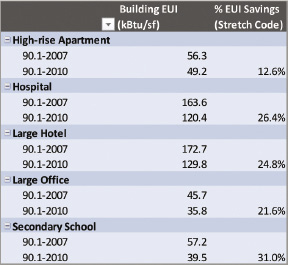In July 2009, Massachusetts became the first state to give local communities the option to adopt a local building standard that is more energy efficient than the state baseline energy code. Since then, more than 130 communities have adopted the Stretch Code in Massachusetts. The MA Stretch Energy Code (Stretch Code) is a voluntary supplement to energy code designed to help communities minimize life-cycle energy costs. This helps them meet criteria contributing to a Green Communities Designation under the Green Communities Act. Becoming a designated Green Community helps communities find and fund clean energy solutions that reduce long-term energy costs. These types of locally rooted efforts in Massachusetts have made it a leader in energy efficiency, renewable energy and emissions reductions. For these types of advances, the American Council for an Energy Efficient Economy (ACEEE) has named Massachusetts number one for three years in a row.
The former MA Base Energy Code is the 2009 International Energy Conservation Code (2009 IECC). The 2009 IECC references ASHRAE 90.1-2007. For large commercial buildings the current Stretch Code requires 20% less energy use than 90.1-2007. The new MA Base Energy Code is the 2012 IECC, which references ASHRAE 90.1-2010. An update to the MA Stretch Code has not been issued and the current Stretch Code will remain in effect until further notice from the Board of Building Regulations and Standards (BBRS). Until an update is issued, the current Stretch Code (90.1-2007) is misaligned with the current MA Base Energy Code (90.1-2010).
The US Department of Energy (DOE) performed energy modeling analysis of standard building types to determine the impacts of switching from ASHRAE 90.1-2007 to ASHRAE 90.1-2010. The table below (Table 1) is based on modeled building energy use data from the DOE's analysis of large commercial building types in a climate similar to MA. Based on the DOE's analysis, the new base code will essentially be 20% more efficient than the outgoing code and equivalent to the current Stretch Code dissipating the benefit of having a stretch energy code.
If the Stretch code is not updated in conjunction with the IECC, the energy efficiency strides provided by the Green Communities Act through adopting a Stretch Code will be lost. The Stretch Code will be rendered ineffective as a tool to help communities minimize life-cycle energy costs. Currently no update to the Stretch Code has been issued by BBRS. Massachusetts should be considering permanently aligning Stretch Code updates with the mandated adoption of IECC codes within a year of their publication.
After the newly released National Climate Assessment, 2014, we should be supporting Massachusetts and its progress in energy efficiency, clean energy, and climate mitigation/adaptation and policies that reaffirm it. This progress, like the progress provided by the Green Communities Act and the adoption of the MA Stretch Energy Code should not be marginalized by our inability to react in a timely nature.
Suzanne Abbott is business developer and Criag Simmons is senior engineer at Vidaris Inc., Boston, MA.
Tags:
MA Stretch Code update needed because it is misaligned with current MA Base Energy Code
June 05, 2014 - Owners Developers & Managers
 (1).png)









